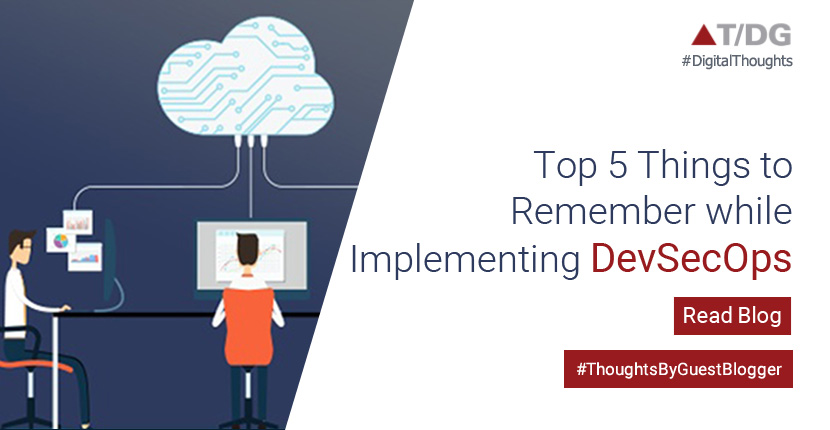Top 5 things to remember while implementing DevSecOps

Businesses are adopting the DevOps approach as the be all and end all methodology to deliver an intuitive and robust customer experience throughout the product lifecycle. While going about this, the Development and Operations teams use automated processes and tools to sustain the Continuous Integration (CI) and Continuous Delivery (CD) pipeline. This way, disparate teams manage to collaborate and tackle critical issues, including having a better control over the product release cycle and delivering quicker updates.
• Management should keep the security aspect in mind while strategizing and setting up schedules.
• Developers should incorporate the security aspect into their code building sprints.
• Testers or QA specialists should test for security apart from the usual performance, functionality, and usability issues.
• Developers should incorporate the security aspect into their code building sprints.
• Testers or QA specialists should test for security apart from the usual performance, functionality, and usability issues.
• Operations should ensure the security aspect is adhered to by the software and deal with any related issues promptly.
DevSecOps implementation needs the building of a quality culture to suit our hybrid computing environments. So, apart from the culture and practices, it entails the use of suitable technologies as well. To enable DevSecOps, all stakeholders (including the security team) should establish a solid chain of communication and under no circumstances should lack of communication impact the implementation.
Salient features of DevSecOps
• Integrating security into identifying and eliminating glitches
• Incorporating security into the building of codes and accessing shared databases
• Incorporating security into the CI/CD pipeline
• Ensuring security is incorporated while updating a software
• Incorporating security into the building of codes and accessing shared databases
• Incorporating security into the CI/CD pipeline
• Ensuring security is incorporated while updating a software
Five things to consider while implementing DevSecOps solutions
#1 Automation of iterative and critical processes: Since the flawless execution of critical processes lies at the core of a quality compliant software application, these need to be automated. The automation process requires the use of DevOps testing tools such as Jenkins and Puppet, among others to streamline the CI/CD workflows. The tools should be able to notify the stakeholders of any glitches or security issues and offer solutions to address them.
The security aspect of an application should be tested by the automation tool at every level of the SDLC – development, integration, testing, installation, deployment, and maintenance. The tools should be able to handle issues like user authentication, public access, and API interaction with protection methods such as expiry of credentials and encryption. The coding method should use secure designs from the early prototype itself.
#2 Security education and training: No matter how rigorous or robust the automated software is, if the people executing DevOps security testing are not aligned with the business objectives, then the process can leave a lot to be desired. Remember, technology alone cannot address the issue but requires the involvement of each and every stakeholder. Merely saying security is everyone’s responsibility will not suffice. Everyone needs to be brought on the same page as far as knowledge and the usage of tools are concerned. For example, developers can be taught to review the code for identifying security glitches in short sprints and checking before using a plugin or library.
#3 Transparency: The biggest obstacle to the streamlining of DevSecOps approach is siloed driven development, security, and operations teams. These siloed teams act as self-contained units with less or no communication among them. To address the issue head on, the teams need to expand their knowledge base and incorporate total transparency.
#4 Create a bespoke DevSecOps strategy: Let us first understand that there is no single way of implementing DevSecOps, and everything depends in the way an organization is constituted and run. The strategy can include embedding the security team into the DevOps team or vice versa. It can also include creating cross functional task forces.
Conclusion
As security takes centre stage with emerging cyber threats, it becomes incumbent on businesses to plug vulnerabilities and make the software applications fool proof. It entails an enhanced collaboration between the development, testing, operations teams (DevOps) on the one hand and the security team on the other.